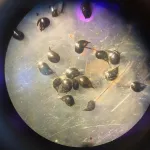(Press-News.org) In a recent article in the Journal of Osteopathic Medicine, authors gathered previously published research to summarize current thinking on the feasibility and efficacy of using scent detection dogs to screen for the COVID-19 virus. The researchers report that sensitivity, specificity, and overall success rates reported by the canine scent detection studies are comparable or better than the standard RT-PCR and antigen testing procedures.
These findings indicate scent detection dogs can likely be used to effectively screen and identify individuals infected with the COVID-19 virus in hospitals, senior care facilities, schools, universities, airports, and even large public gatherings for sporting events and concerts.
"Accurate and rapid screening of individuals who may be carriers, symptomatic or asymptotic, of the COVID-19 virus will remain important for slowing and limiting the spread of infection," said Tommy Dickey, PhD, professor, University of California, Santa Barbara. "These preliminary studies suggest the use of medical scent detection dogs offers a promising approach."
Documented success detecting disease
Dogs can sense a broad range of molecules with extremely small concentrations: 1 part in a quadrillion compared with 1 part in 1 billion for humans. This capability is used for search and for identification of diseases with their individual chemistries and odors.
Using inhaled air molecules and particulates, dogs can detect odorous human molecules (volatile organic compounds, or VOCs) that originate from flaked off skin or hair cells, blood, breath, saliva, sweat, tears, nasal mucous, urine, semen, or feces. Since smells linger, dogs can maintain a historical library of the smells of complex molecules.
"The science behind and efficacy of using dogs in detecting medical conditions and diseases such as cancers, diabetes, malaria, Parkinson's disease, and more has been documented," said Heather Junqueira. "These new studies provide support for additional research to determine their ability to detect COVID-19 at scale."
The qualified studies
For their review, the authors assessed four recent studies analyzing the success of scent detecting dogs at identifying VOCs associated with COVID-19. First, they described the work of a team of collaborating researchers from France and Lebanon, who tested with 8 dogs that had previously been trained to detect both explosives and colon cancer.
These dogs were independently presented with cotton or wool gauze samples that had been soaked with sweat from one of 198 human armpits of patients in different hospitals. While the COVID-19 virus does not itself have a smell, researchers hypothesized that the resulting infection generates metabolic changes, which cause the release of a distinctive type of sweat odor that can be detected by a dog.
The dogs were trained to only sit in front of a COVID-19-positive sample contained in a box with a sample canister. After four days of training using COVID-19 samples, the success rate for the dogs ranged between 83 and 100%.
Saliva or tracheobronchial secretions
In another study described by the authors, a research team in Germany conducted a randomized, double-blinded, controlled pilot study to determine whether previously trained scent dogs could successfully detect the presence of the COVID-19 virus. Dogs were trained over 1 week to detect the COVID-19 virus in samples of saliva or tracheobronchial secretions collected from infected patients.
Each dog, its handler, and the person observing the study were blindfolded. The number and duration of each dogs' "nose dips" into the scent holes, along with the location of the positive and negative samples, were automatically recorded and verified using time-stamped video analysis, which automated the process and reduced trainer interference.
The results, derived from 1,012 automated sample presentations, showed an overall average detection rate of 94%: 157 correct indications of positive, 792 correct rejections of negative, 33 false positives, and 30 false negative indications. Interestingly, the team reported no notable difference in detection ability between the use of sample saliva and sample tracheal secretion.
While that pilot study had limitations--in particular, the positive samples came only from severely affected, hospitalized COVID-19 patients and the negative samples were from healthy individuals with no indications of respiratory infections--the authors of the present study found those results encouraging.
Support for additional research
A third study done by a team in Colombia tested 6 trained scent dogs of various and mixed breeds to develop a screening method for detecting COVID-19 in individuals who may be asymptomatic, pre-symptomatic, or symptomatic.
The researchers developed a device to safely expose the scent-trained dogs to VOC samples collected from respiratory secretions of COVID-19-positive patients, and their detailed study was conducted in 3 phases, with the third phase ongoing.
"Of the 6,000 samples, the dogs' performances [in that study] resulted in a sensitivity of 95.5% and a selectivity of 99.6%," said Dickey. "The high success rates among different types of dogs suggests a range of breeds or mixed breeds may be trained to effectively screen for COVID-19."
Challenges remain
"The results of recently reported and ongoing research are encouraging; however, there remain challenges to be considered before broad-scale implementation of scent detecting dogs to identify and screen for COVID-19," said Junqueira. "Nonetheless, the research supports the use of scent detection dogs for pilot COVID-19 screening studies in venues such as airports and sporting events."
The authors hope that their research review, which presented recent information and perspectives on the potential for broad application of trained scent dogs for screening of COVID-19-infected individuals, can be used to assist in the development of future studies and implementation of screening programs to benefit preventative medical research.
INFORMATION:
About the Journal of Osteopathic Medicine
The Journal of Osteopathic Medicine, founded in 1901 and known for 119 years as The Journal of the American Osteopathic Association, is the premier scholarly, peer-reviewed publication of the osteopathic medical profession. JOM conducts peer review of academic research manuscripts from a wide variety of medical specialties, covering the full spectrum of clinical settings in which osteopathic physicians practice. All submissions are vetted by a distinguished group of Section Editors led by Editor-in-Chief Ross Zafonte, DO, and supported by a full Editorial Board.
EUGENE, Ore. -- Feb. 11, 2021 -- Researchers have mined and combined information from two databases to link pollen and key plant traits to generate confidence in the ability to reconstruct past ecosystem services.
The approach provides a new tool to that can be used to understand how plants performed different benefits useful for humans over the past 21,000 years, and how these services responded to human and climate disturbances, including droughts and fires, said Thomas Brussel, a postdoctoral researcher in the University of Oregon's Department of Geography.
The approach is detailed in a paper published online ...
Palo Alto, CA-- Understanding how plants respond to stressful environmental conditions is crucial to developing effective strategies for protecting important agricultural crops from a changing climate. New research led by Carnegie's Zhiyong Wang, Shouling, Xu, and Yang Bi reveals an important process by which plants switch between amplified and dampened stress responses. Their work is published by Nature Communications.
To survive in a changing environment, plants must choose between different response strategies, which are based on both external environmental factors and internal nutritional and energy demands. For example, a plant might either delay or accelerate its lifecycle, depending on the availability of the stored ...
A negative experience with food usually leaves us unable to stomach the thought of eating that particular dish again. Using sugar-loving snails as models, researchers at the University of Sussex believe these bad experiences could be causing a switch in our brains, which impacts our future eating habits.
Like many other animals, snails like sugar and usually start feeding on it as soon as it is presented to them. But through aversive training which involved tapping the snails gently on the head when sugar appeared, the snails' behaviour was altered and they refused to feed on the sugar, even when hungry.
When the team ...
FRANKFURT. More than two thirds of the earth is covered by clouds. Depending on whether they float high or low, how large their water and ice content is, how thick they are or over which region of the Earth they form, it gets warmer or cooler underneath them. Due to human influence, there are most likely more cooling effects from clouds today than in pre-industrial times, but how clouds contribute to climate change is not yet well understood. Researchers currently believe that low clouds over the Arctic and Antarctic, for example, contribute to the warming of these regions by blocking the direct radiation of long-wave heat from the Earth's surface.
All ...
Low-income middle-aged African-American women with high blood pressure very commonly suffer from depression and should be better screened for this serious mental health condition, according to a study led by researchers at the Johns Hopkins Bloomberg School of Public Health.
The researchers found that in a sample of over 300 low-income, African-American women, aged 40-75, with uncontrolled hypertension, nearly 60 percent screened positively for a diagnosis of depression based on a standard clinical questionnaire about depressive symptoms.
The results appeared February 10 in JAMA Psychiatry.
"Our findings suggest that low-income, middle-aged African-American women with hypertension really should be screened for depression symptoms," ...
CHAMPAIGN, Ill. -- People who participated in a health education program that included both mental health and physical health information significantly reduced their risks of cardiovascular disease and other chronic diseases by the end of the 12-month intervention - and sustained most of those improvements six months later, researchers found.
People who participated in the integrated mental and physical health program maintained significant improvements on seven of nine health measures six months after the program's conclusion. These included, on average, a 21% ...
New research shows that biodiversity is important not just at the traditional scale of short-term plot experiments--in which ecologists monitor the health of a single meadow, forest grove, or pond after manipulating its species counts--but when measured over decades and across regional landscapes as well. The findings can help guide conservation planning and enhance efforts to make human communities more sustainable.
Published in a recent issue of Frontiers in Ecology and the Environment, the multi-institutional study was led by Dr. Christopher Patrick ...
STEMOs (Stroke-Einsatz-Mobile) have been serving Berlin for ten years. The specialized stroke emergency response vehicles allow physicians to start treating stroke patients before they reach hospital. For the first time, a team of researchers from Charité - Universitätsmedizin Berlin has been able to show that the dispatch of mobile stroke units is linked to improved clinical outcomes. The researchers' findings, which show that patients for whom STEMOs were dispatched were more likely to survive without long-term disability, have been published in JAMA*.
The phrase 'time is brain' emphasizes a fundamental principle from emergency medicine, namely that after stroke, every minute counts. Without ...
With the help of the international Gemini Observatory, a Program of NSF's NOIRLab, and other ground-based telescopes, astronomers have confirmed that a faint object discovered in 2018 and nicknamed "Farfarout" is indeed the most distant object yet found in our Solar System. The object has just received its designation from the International Astronomical Union.
Farfarout was first spotted in January 2018 by the Subaru Telescope, located on Maunakea in Hawai'i. Its discoverers could tell it was very far away, but they weren't sure exactly how far. They needed more observations.
"At that time we did not know the object's orbit as we only had the Subaru discovery observations over 24 hours, but it takes years of ...
A report summary released today by a team at Lehigh University led by Thomas McAndrew , a computational scientist and assistant professor in Lehigh's College of Health, shares the consensus results of experts in the modeling of infectious disease when asked to rank the top 5 most effective interventions to mitigate the spread and impact of COVID-19 in the U.S.
The report is part of an ongoing meta forecasting project aimed at translating forecasting and real world experience into actions.
McAndrew and his colleagues wanted to answer "Here is where ...




